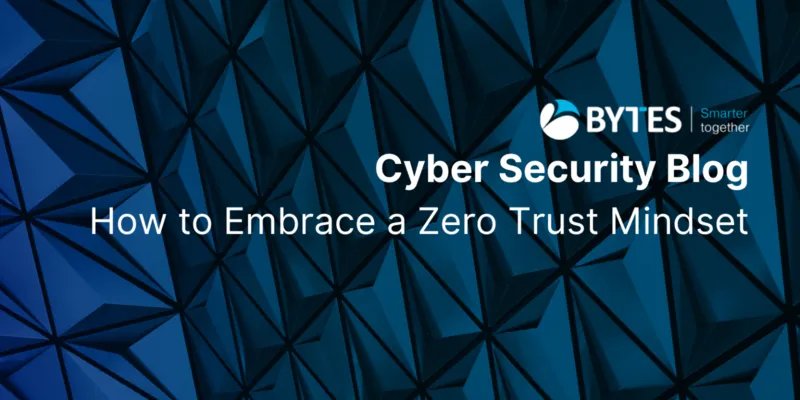Bytes Blog: How to Embrace a Zero Trust Mindset

Wednesday 15th March 2023
Thursday 16th March 2023
Writer: Gennaro Migliaccio, Contributor: Giuseppe Damiano, Editor: Daniela Miccardi
_______________________
As humans our natural mindset establishes ‘Trust’ until proven otherwise. In recent years, we’ve been forced to shift this outlook by leading with a ‘Zero Trust’ approach – assuming all is ‘bad’ and until verification is complete. This change is not simply down to a shift in solutions and architecture, but an evolved approach to how we see security in general.
One of the hardest parts of implementing Zero Trust IS the mindset shift and whilst security-savvy individuals will be used to this, the rest of the business may not be. The goal of Zero Trust is ultimately a change a user’s frame of mind to one that assumes all devices have been compromised and therefore become a potential threat. Whilst this level of suspicion can seem excessive to some, it is justified by the ever-evolving threat landscape (increasing attacks, exploits etc).
What does a Zero Trust Mindset require?
The initial answer to this question is relatively easy: assume you are compromised. Typically, any device, service, or environment needs to be treated this way. The reasoning behind this is to mentally prepare for the inevitable cyber-attack and to encourage the use of additional layers of detection and visibility, as well as making people more receptive/vigilant about any suspicious or strange behaviour.
It is also important to be mindful that any type of access approval to privileged or critical resources will increase risk. We therefore need to assume all requests related to business-critical resources are malicious. This is where using least-privilege access and verifying identity explicitly is critical. Individuals need to understand that granting any type of escalated access comes with risk, and this risk needs to be managed by solutions and processes.
Finally, it is important to create a change in culture that moves away from reactive incident management to proactive monitoring, detection, and response, contributing to reducing the chances of damage or other negative impact caused. Accept that this change will take time and your Zero Trust strategy will need to be dynamic and flexible to support it whilst still working towards the key objectives.
Summary
You are not alone in your struggle with this mindset shift; every business is going through this, each with their own nuances. Zero Trust is a long-term strategy, one that is unique to your business.
As a final note, one of the most important things about Zero Trust is that Zero Trust isn’t an architecture or a solution, it’s a strategy. One that, if built and implemented correctly, can be flexible to adapt to the everchanging threat landscape. It truly is a combination of People, Processes and Technology, making the mindset shift a necessary step for Zero Trust to be successful and valuable to a business.
Thank you for reading.
If you have any questions, or would like to learn more about any of the topics covered in this blog, please email our friendly team via [email protected].
Want to keep informed? Sign up to our Newsletter

